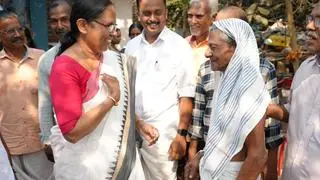It’s Kutch’s moment in the Sun, literally. As Prime Minister Narendra Modi lays the foundation stone on Tuesday for what is dubbed as the world's largest single-location hybrid energy park in Vighakot village, this border district in Gujarat aspires to become a global renewable energy powerhouse.
From the days of darkness in the pre-Independence era to giant windmills and shining solar panels covering large swathes today, Kutch has transformed into an energy hub.
The upcoming 30 Gigawatt (GW) renewable energy hybrid park — wind and solar — is seen as a big step for India in its commitment towards climate change. About a fifth of the targeted 175-GW of renewable energy in the country will now be in Kutch. The State government estimates the project will get investments of ₹1.25-lakh crore from solar and wind players, who will sell the electricity generated to the Solar Energy Corporation of India (SECI).
The first light
Kutch's first encounter with electricity happened in 1915 at a wedding function of the princely family of late Maharao Madansinhji Jadeja. The Darbargarh palace was lit up with electric lamps powered by a specially-arranged 110-Watt 15-horsepower diesel engine.
Then came its first 6-MW thermal plant set up at Kandla in 1959 and subsequently a lignite-based plant at Panandhro, the foundation stone of which was laid by then Prime Minister Morarji Desai in November, 1979. The preference and technology was for mineral-based power generation to tap into Kutch's rich lignite deposits.
As the thermal capacities kept increasing, the district that is spread over 45,600 square km — a little bigger than Switzerland — saw an influx of investors from the power sector, mostly coal-based. Tata Power's 4,000 MW thermal plant under the Central government's Ultra Mega Power Project (UMPP) scheme and Adani Group’s 3,300 MW Supercritical Mundra Power Project turned Kutch into a power house.
But a big renewable energy push came in the early 2000s through the State nodal agency, Gujarat Energy Development Authority. Suzlon Energy became the driver for Kutch's windmill revolution even as environmentalists raised concerns over its impact on migratory birds.
While locals hail Kutch’s remarkable work on the energy front, they have a few demands too. “The district must get incentives such as subsidised power in return. The water-starved district still awaits full-fledged access to the Narmada canal network,” said Kirti Khatri, a veteran on Kutch development.








Comments
Comments have to be in English, and in full sentences. They cannot be abusive or personal. Please abide by our community guidelines for posting your comments.
We have migrated to a new commenting platform. If you are already a registered user of TheHindu Businessline and logged in, you may continue to engage with our articles. If you do not have an account please register and login to post comments. Users can access their older comments by logging into their accounts on Vuukle.